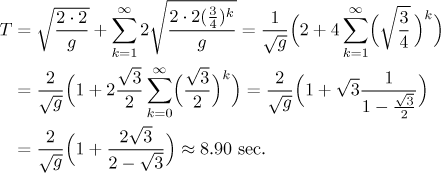
Problem: A certain rubber ball when dropped on a hard floor bounces
back up to the
Solution: The ball starts bouncing and bounces and bounces and bounces, the height of the bounce is getting smaller and smaller. Our assumption means that even when the jumps are very tiny, the mechanism stays the same, and so the ball actually bounces infinitely many times.

Thus to find the total distance of travel we have to sum up a series. To see
which one we will have a closer look at the heights that the ball reaches in
its jumps. Obviously we use the fact that each jump has

Thus we see that the first leg is a bit special (it is only one way), but then we add two times terms that obviously form a geometric series.

Since the base

We ignored some fairly substantial influences. A "real" ball has some elasticity and gets deformed at the moment of bounce. When the bounces are really small, they do not even lift the ball off the floor, they just stretch it a bit up, then it gets squeezed a bit and the resistance to this is so strong that the ball shortly stops. However, this happens only if the jumps are very tiny and that did not contribute very much to the total displacement calculated above. Thus the error is small and the figure 14 meters is a rather good approximation.
Bonus: We return back to the idea of the ball making infinitely many jumps. How long does it take? First, we will find how long does it take for the ball to fall to the floor when dropped from the height h. We will ignore the effect of air resistance since for a bouncing ball it does not have a substantial influence. The starting velocity is zero (the ball is on the top of its jump), so we get

Next we claim that the time on the upward leg is the same as the time on the
downward leg. Let's investigate one jump. The initial velocity (at the
ground) v0 decreases as the ball rises, eventually
becoming zero on the top. If t0 is the time it takes, we
get the formula
Now we look at this situation through the eyes of energy (and recall that we
ignore loses like friction). The kinetic energy related to the velocity
v0 first entirely changes into potential energy (top of
the jump) and then back to kinetic energy (we take the ground as the zero
level for potential energy). From thsi it follows that
We now know the times it takes to cover all the legs in the above picture, so we sum them up.
